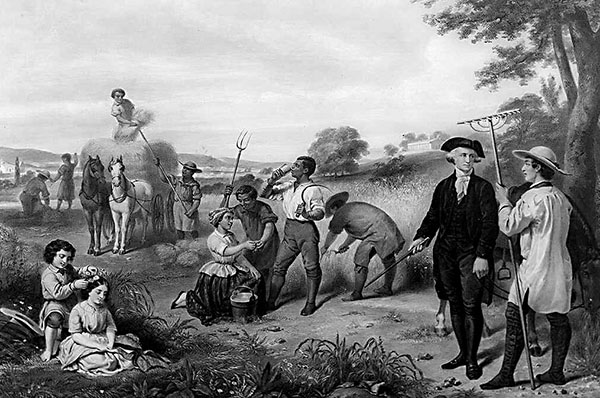The slave Ona Judge was Martha Washington’s chief personal attendant for seven years. But rather than remain the First Lady’s servant, she ran away in 1796.
Ona Judge was Martha Washington’s chief attendant from about 1789 to 1796. Before she selected Judge as her principal attendant, Martha Washington had long admired her skills in weaving cloth, spinning thread and making clothes. She made clothes for George and Martha Washington and their slaves at Mount Vernon, George Washington’s Virginia plantation.
Ona Judge Becomes Washington’s Servant
At Mount Vernon, Judge also made soap, churned butter, dipped candles, washed clothes and prepared meals. In 1789 when Judge was about 15 or 16 years old, Martha Washington selected her as her body servant. Martha Washington was now the First Lady and she and the newly elected president were preparing to move to the official presidential residence in New York, then the nation’s capital.
From 1790 to 1800 Philadelphia was the nation’s capital. When the president and Mrs. Washington moved to the President’s House in Philadelphia in November 1790 they took Judge and some other enslaved Africans with them.
Ona Judge’s Parents
Judge’s mother was the Mount Vernon slave seamstress Betty. Judge’s father was Andrew Judge, a white indentured servant from Leeds, England, who had come to America in 1772. He was a tailor at Mount Vernon. After four years there, Judge gained his freedom while Betty and his daugher remained enslaved. No images of Ona Judge are known to exist but she was light-skinned because a white contemporary of hers who had visited the Washingtons’ main house noted that all the slaves laboring there had skin color like a white person.
As Washington’s chief body servant, Judge helped her to bathe and dress and undress. She also combed her hair and starched the caps she always wore on her head. When Washington visited her female friends and acquaintances who were the wives of influential men, she took Judge with her. While Washington was meeting her social obligations, Judge passed her time in the kitchen talking with the slaves and hired help.
Judge Decides to Run Away
At the President’s House in Philadelphia, President Washington signed the Fugitive Slave Act of 1793 into law. It allowed slaveowners to recapture their slaves, go to a local court in the state of recapture, present proof of ownership and be issued a certificate permitting them to take their slaves backinto bondage.
The law also imposed a $500 fine on anyone who tried to help a slave escape or tried to hinder the efforts of anyone who was trying to recover the slave. (The Liberty Bell today is housed is a pavilion that is on the same site where the President’s House and its associated structures once stood.)
Following the March 1796 marriage of her granddaughter Elizabeth Custis, Martha Washington told Judge that she would be a wedding gift to the newlywed couple. They had honeymooned at the Washingtons’ residence. Not wanting to be a slave all her life, Judge decided to try to escape from the northern city of Philadelphia rather than try the escape from Mount Vernon, where the Washingtons would return in 1797 when George Washington’s presidency ended.
A New Life in New Hampshire
Judge had friends among the free blacks in Philadelphia. Someone either slave or free carried her packed clothes out of the President’s House prior to her escape. She fled in May or June 1796 as the Washingtons were eating dinner. She hid in a house in Philadelphia until blacks directed her to the sailing vessel Nancy, which landed in Portsmouth, New Hampshire. In Portsmouth
in January 1797 Judge married Jack Staines, a black sailor. They had three children: Eliza, Nancy and William. After Staines died in 1803, Ona Maria Judge Staines – as she was then known – worked briefly as a maid in a private residence. (As a slave she was most likely called Oney. But she preferred the name Ona.) But soon she and her children moved to Greenland, New Hampshire and became boarders in the home of a black family named Jacks.
Life As an Elderly Woman
Judge’s children died before she did. As she aged, doing manual labor to earn money was not possible. The Jacks daughters with whom she continued to board were also aged. The women survived because the community of Greenwood, which had very few blacks,gave them wood for fuel and food.
Despite the hardship of her life, In an interview printed in a New Hampshire newspaper in 1845, Judge said that she never regretted seizing her freedom. She died in Greenland on February 25, 1848. Because of the Fugitive Slave Act of 1793, she was a fugitive for the last 52 years of her life.
Sources:
- Adams, T. H. “Washington’s Runaway Slave and How Portsmouth Freed Her” in the Granite Freeman(Concord, NH), May 22, 1845 reprinted in Frank W. Miller’s Portsmouth New Hampshire Weekly, June 2, 1877. USHistory.org. Accessed 11 August 2008.
- Gerson, Evelyn. “Ona Judge Staines: Escape From Washington.” Seacoastnh.com. Accessed 19 December 2008.
- “Martha Washington: The 1790s.” Marthawashington.us. Accessed 15 May 2010.
- Thompson, Mary V. “Different People, Different Strokes The Life Stories of Individual Slaves From Mount Vernon and Their Relationship With George and Martha Washington.” Talk at Symposium. George Washington & Slavery. Mount Vernon, VA. 3 November 2001. Revised April 2002.








